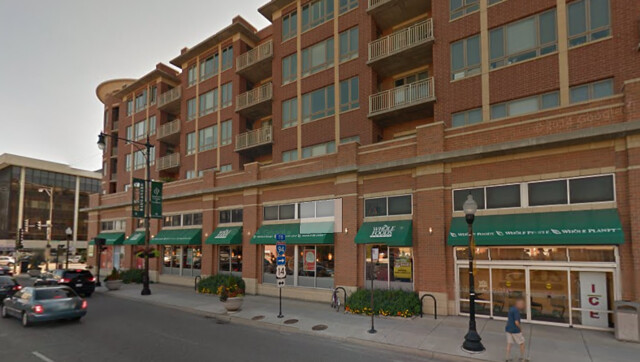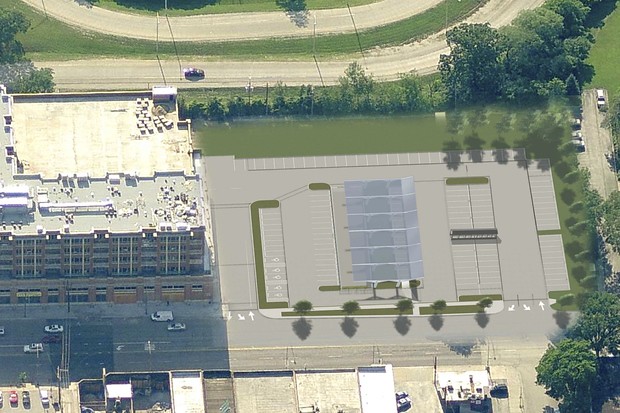Sauganash Place, a mixed-use development near Peterson and Cicero avenues, is a strikingly urban element in the eponymous Chicago neighborhood, a quiet, mostly residential community on the Far Northwest Side. Featuring several stories of condominiums with balconies, plus a Whole Foods Market on the ground floor, the building wouldn’t look out of place in denser neighborhoods like Lincoln Park and Lakeview.
Although the supermarket already has a large underground parking garage, as well as a surface parking lot, the company recently announced it has purchased land to the north of the store -- which was originally slated for more condos -- in order to expand the lot. The plan is moving forward with little-to-no opposition, even though it would be much more productive to use this land for development, especially for more multi-unit housing.
The original proposal for Sauganash Place included two condo buildings with a total of 136 units, plus commercial space. The completed portion, built in 2007, includes the Whole Foods, 61 condo units, and 260 garage parking spaces in garages. Due to the housing market crash that occured shortly after that, the second building was never constructed. The site is currently a gravel lot, which Whole Foods is already using for parking.
The store’s plan to permanently convert the land to car storage was approved by the Chicago Department of Planning and Development and the Chicago Department of Transportation, as well as 39th Ward Alderman Margaret Laurino and local community leaders. “The Alderman is satisfied that the proposal is the right fit for that location,” said John Riordan, the ward’s director of economic development and business affairs.
However, more space for people, rather than cars, would have been a much better community asset. The predominant housing type in Sauganash is single-family housing. Over 85 percent of all units in the Forest Glen community area – which includes Sauganash, Forest Glen, Edgebrook, and Wildwood -- are single-family units, according to DePaul University’s Institute for Housing Studies. Condos and apartments located in buildings with six or more units only make up about six percent of the area’s total units.
Citywide, only about 25 percent of housing units are single-family homes. Even in other Far Northwest Side community areas, the percentage of housing units represented by single-family homes is much lower than in Forest Glen, which has one of the highest single-family home percentages of any community area.
DPD’s current housing plan, entitled “Bouncing Back: Five-Year Housing Plan” explicitly states, “People of all income levels, in all neighborhoods, should have a range of housing options.” It goes on to say “A commitment to diverse communities and…fair housing is essential to a healthy, vibrant Chicago.” Whole Foods' plan to permanently convert valuable land to parking is in conflict with those goals.
There are few available sites for new multi-unit projects in Sauganash. By approving this parking lot, Laurino passed up an opportunity to push for a more constructive use of the land. Instead, the community is getting a project with a very narrow scope of benefits.
Whole Foods said the new parking lot will likely incorporate green technology such as solar-powered lighting and permeable pavers, and it may host a farmers market and other community events. However, it’s essentially just a place to store customers’ cars, and it doesn’t even appear that there’s any demand for the additional parking capacity. No parking study was conducted, according to Whole Foods representative Keith Stewart.
Anecdotally, my experience has been that, even when the surface lots are full, there are always plenty of spaces in the store’s large underground garage. It appears building the new lot is more about accommodating shoppers’ preference to park at street level, than any actual need for more parking. As such, it’s a highly wasteful project.
As Stewart pointed out, Whole Foods isn’t in the real estate development business. However, it is in the sustainability business. Part of the appeal of shopping at the stores is their green image. Whole Foods’ website lists “Reducing waste and consumption of non-renewable resources” as part of the company’s core values. It behooves them to think about how development and transportation fit into this mission.
Laurino’s office acknowledged that there have been other proposals to build condos on the site, but said these all fell through. However, the housing market is improving, and new housing is being built elsewhere in the neighborhood, so why did the alderman give up on trying to get condos or apartments built here?






